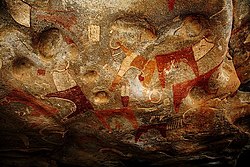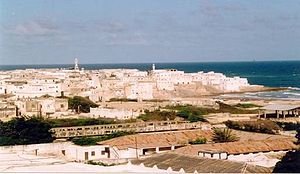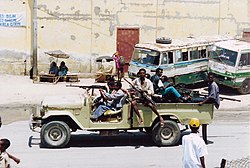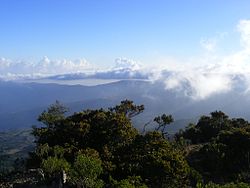User:Mu/Sandbox1: Difference between revisions
| Line 175: | Line 175: | ||
===Transitional Period and Contemporary Era=== | ===Transitional Period and Contemporary Era=== | ||
{{main|XXXX Accords (2009)|Tusani Transitionary Authority (2009-2010)}} | {{main|XXXX Accords (2009)|Tusani Transitionary Authority (2009-2010)|Tusani insurgency (2009-present)}} | ||
[[File:Al Shabaab fighters disengage and lay down arms 03 (8019356109).jpg|250px|thumb|right|Rebel fighters disarming under [[Tusani Transitional Authority (2009-2010)|Transitional]] and [[Community of Nations|international]] supervision.]] | [[File:Al Shabaab fighters disengage and lay down arms 03 (8019356109).jpg|250px|thumb|right|Rebel fighters disarming under [[Tusani Transitional Authority (2009-2010)|Transitional]] and [[Community of Nations|international]] supervision.]] | ||
The signing of the [[XXXX Accords (2009)|2009 peace accords]] on 3rd August, 2009 between the forces of the [[Tusani Liberation Army]], the [[Irfanic Union (Tusania)|Irfanic Union]], the [[Tusani Youth League]], and their subordinate paramilitary organizations, brought a technical end to the twelve year civil war. Rebel forces began to disarm, under the supervision of the [[Community of Nations]] {{wp|United Nations peacekeeping|peacekeepers}} under the [[Community of Nations Observation Mission in Tusania|CNOMT]], later that same year. Concurrently, the Community of Nations authorized the creation of the [[Tusani Transitionary Authority (2009-2010)|Tusani Transitional Authority]] ({{wp|Somali language|Toosani}}: ''Maamulka ku meel gaarka ah ee Toosiyanka''; {{wp|French language|Gaullican}}: ''Autorité transitoire de Tusanienne''; {{wp|German language|Weranian}}: ''Tusanisch Übergangsbehörde''; {{wp|Arabic language|Badawiyan}}: سلطة توساني الانتقالية {{wp|transliteration|tl.}} ''Sultat Tusani al-Aintiqalia'') as a {{wp|transitional government}} body which would see the country's [[Constitution of Tusania#2009 amendments|constitutional]] transition into peace. | |||
[[Siyaad Geyre]], a Toosani [[Zeilaayo (clan)|Zeilaayo]] politician and technocrat, was selected as the [[Head of state of Tusania|Chairman of the Executive Council of the Tusani Transitional Authority]] and would hold the position for the duration of the transition. Chairman Geyre quickly set about establishing agreements with regional and international nations and bodies, such as [[Gaullica]], [[Zorasan]], the [[Global Institute for Fiscal Affairs]], and the [[International Trade Organisation]], in order to secure funding to finance the national reconstruction process. In addition, he also began signing multiple trade deals in order to re-establish local Tusani industries, infrastructure, and economic capacity. | |||
In addition, Geyre set about re-establishing and re-constituting the [[Tusani Defence Forces|Tusani armed forces]], which had largely fragmented and splintered over the course of the civil war. This was largely due to a burgeoning [[Tusani insurgency (2009-present)|insurgency]] by {{wp|Islamic terrorism|Irfanic terror groups}} such as the [[Followers of God (terror group)|Ehellada Ilaahay]], the [[Movement of Pious Youth (terror group)|Dhaqdhaqaaq ee Daacadnimo Dhallinyar]], and the [[The Enlightened (terror group)|Iftiimiyay]], who were carrying out a ruthless {{wp|Spree killer|shootings}}, {{wp|car bomb|car bombings}}, and other {{wp|suicide attack|suicide attacks}}. This was done largely with the assistance of [[Gaullica]] and other international powers. | |||
On 1 May, 2010, inaugural elections were held, with [[Siyaad Geyre]] being elected as the first [[Head of state of Tusania|President]] of the country under the new constitution, who then selected [[Muxumed Hareeri]] as his first [[Head of government of Tusania|Prime Minister]]. Within the newly established [[National Assembly (Tusania)|National Assembly]] the election saw Geyre's party, the [[Union for National Development]], create a majority government in both chambers alongside the [[Transformation Coalition]]. The government would become official with the dissolution of the TTA on 31 December, 2011. | |||
[[2014 Tusanian parliamentary elections|Elections]] in 2014 would see the UND-TC coalition gain further control over the legislature. That year a [[Week of Terror (Tusania)|series of terror attacks]] would rock the nation and see the death of over 250 people, as well as an additional 12 CNOMT personnel, prompting the deployment of additional troops in the region and a ramping up of military training within the TDF. | |||
In 2016 Prime Minister Hareeri declined to accept the President's nomination, paving the way for current Prime Minister [[Kulane Xirsi]] to serve the office. | |||
==Geography== | ==Geography== | ||
Revision as of 06:59, 12 December 2019
Republic of Tusania | |
|---|---|
| Motto: “Caddaalad iyo Nabadu Dhammaan” (Toosani) “Justice and Peace unto All” | |
| Anthem: Mahad waxaa leh Dalkeena Hooyo (Toosani) Praise be to Our Homeland | |
| Capital and largest city | Gulaayo |
| Official languages | Toosani Badawiyan Gaullican Weranian |
| Recognised regional languages | Ilaahow |
| Ethnic groups (2011) | 84% Toosani 10% tooBantu 5% Badawi 1% Other |
| Religion (2011) | 90% Irfan 5% Solarian Catholicism 5% Other |
| Demonym(s) | Toosani (ethnic) Tusani (citizen) |
| Government | Federal multi-party semi-presidential parliamentary constitutional republic |
| Siyaad Geyre | |
| Kulane Xirsi | |
| Jamiila Cagmadhige | |
| Muxumed Tarabi | |
| Legislature | National Assembly |
| Assembly of Jurors | |
| Assembly of Experts | |
| Independence from ?????? | |
| 19XX | |
| 1967 | |
• Golaha | 1968 |
| 1997-2009 | |
| 2009 | |
| 2010 | |
| Population | |
• 2019 estimate | |
• 2011 census | 15,627,372 |
| GDP (PPP) | 2019 estimate |
• Total | |
• Per capita | |
| GDP (nominal) | 2019 estimate |
• Total | |
• Per capita | |
| Gini (2019) | high |
| HDI (2018) | low |
| Currency | Tusani pound (TSp) |
| Date format | dd-mm-yyyy CE |
| Driving side | right |
| Calling code | +50 |
| ISO 3166 code | TSN |
| Internet TLD | .tsn |
Tusania (/tjuːsɑːnjiɑː/, known formally as the Republic of Tusania (Toosani: Jamhuuriyadda Toosiyanka; Badawiyan: جمهوريه توسانيه tl. Jumhuriat Tusaniyah; Gaullican: République Tusanienne; Weranian: Republik Tusanisch) is a sovereign nation located along the Coast of Bahia on the mainland of the continent of Coius. It borders Habasha to the south, NULL to the north, the Coast of Bahia to the east, NULL to the west, and Tabora to the southeast across the Bay of XXXX. It also maintains jurisdiction over the island of Kisgomane, which lies within the Vehemens Ocean itself. Tusania has an estimated population of 17,839,329 as of 2019, ranking it as the XXth most populous nation in Coius and the XXth most populous in the world. It has a total land area of XXXkm2 (XXXsqmi), making it the XXth largest in Coius and the XXth largest in the world. Its capital is the city of Gulaayo, which is also its largest city.
Tusania has long been under the control of a series of clans for thousands of years, many of whom have either formed independent polities of their own or have paid fealty to more powerful rulers from the Bahian interior. The clans of the region would finally unify under the Sultanate of Damaxato in the 15th-century. The sultanate would remain stable and prosperous until the mid-XXth century, when it was systematically dismembered by both Weranian and Gaullican forces and incorporated into each nation's colonial holdings as part of the colonies of Adésine, Dacie, and Weranian Bahia. The rise of national functionalism in Gaullica would see the Toosani people in Adésine and Dacie undergo significant hardship under their colonial masters due to their anti-Bahian and anti-Irfanic policies, and the Great War would have the region see much fighting between Weranian and Gaullican forces throughout the conflict. Following the conclusion of the war the region was designated a Community of Nations Trust Territory of Tusania under XXXX Administration until 19XX, when it became independent as the Sultanate of Tusania.
Tensions between the population and the ruling clans, as well as the introduction of the ideals of Bahian socialism, pan-Bahianism, as well as Irfanic socialism and political Irfan resulted in riots, strikes, protests, and general unrest which culminated in the Tusani Revolution by socialist revolutionaries in the Revolutionary Socialist Union Party in 1967. The revolutionaries, known as the Golaha, would found the Tusani Socialist Republic that same year. Though initially ruling benevolently, economic stagnation and increasing political unrest led to the Golaha to become increasingly repressive and manipulative in their attempts to maintain control, using coercion between the clans in order to secure loyalties. Protests calling for reforms and a subsequent crackdown sparked a mass civil uprising that would eventually morph into a multi-sided civil war, which would see much of the country fragment along clan and religious lines. The civil war would largely end in 2009 with the signing of the XXXX Accords, though some groups, particularly Irfanic terror groups, refused to demobilize and have since vowed an insurgency against the government. Since then the country has become a relatively stable semi-presidential parliamentary republic, albeit one which struggles to maintain democracy within its institutions, which has been overseen by President Siyaad Geyre and Prime Minister Kulane Xirsi and the Union for National Development since the end of the civil war.
Tusania is a member of the Community of Nations, the International Trade Organisation, the Global Institute for Fiscal Affairs, the Congress of Bahian States, and is an observer within the SOMEBADAWIYANORGANIZATION.
Etymology
The word "Tusania" is believed to be a Eucleanisation of the Toosani word for "upright," or "toosan". The phrase was adopted as an endonym by the tribes and clans of the region to describe themselves following the unification of the region under the Sultanate of Damaxato as a statement of their independence and self-reliance. Following the colonization of the region by Gaullica and Werania use of the name was discontinued, with the region being folded into colonial holdings as part of the Gaullican colonies of Dacie, Adésine, and parts of Bahia-Centrale and Weranian Bahia.
Use of the word, now to describe the region as a whole, began to be introduced once again following the Great War, with the region being designated by the Community of Nations as the Trust Territory of Tusania under Weranian Administration until 1955. That year the signing of the Lawgeisa Agreement saw the independence of the region under the Sultanate of Tusania and the first official use of the word to describe the region as an independent state as well as within constitutional and legal documentation. Generally accepted by this time, usage continued with the founding of the Tusani Socialist Republic, was maintained through the transitional period following the Tusani Civil War, and has been in continued use with the current government.
History
Pre-History
Early History
Early Colonial Rule
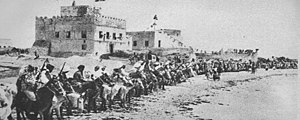
Great War and Later Colonial Rule

Independence and Revolution

Socialist Rule and Civil War
Transitional Period and Contemporary Era
The signing of the 2009 peace accords on 3rd August, 2009 between the forces of the Tusani Liberation Army, the Irfanic Union, the Tusani Youth League, and their subordinate paramilitary organizations, brought a technical end to the twelve year civil war. Rebel forces began to disarm, under the supervision of the Community of Nations peacekeepers under the CNOMT, later that same year. Concurrently, the Community of Nations authorized the creation of the Tusani Transitional Authority (Toosani: Maamulka ku meel gaarka ah ee Toosiyanka; Gaullican: Autorité transitoire de Tusanienne; Weranian: Tusanisch Übergangsbehörde; Badawiyan: سلطة توساني الانتقالية tl. Sultat Tusani al-Aintiqalia) as a transitional government body which would see the country's constitutional transition into peace.
Siyaad Geyre, a Toosani Zeilaayo politician and technocrat, was selected as the Chairman of the Executive Council of the Tusani Transitional Authority and would hold the position for the duration of the transition. Chairman Geyre quickly set about establishing agreements with regional and international nations and bodies, such as Gaullica, Zorasan, the Global Institute for Fiscal Affairs, and the International Trade Organisation, in order to secure funding to finance the national reconstruction process. In addition, he also began signing multiple trade deals in order to re-establish local Tusani industries, infrastructure, and economic capacity.
In addition, Geyre set about re-establishing and re-constituting the Tusani armed forces, which had largely fragmented and splintered over the course of the civil war. This was largely due to a burgeoning insurgency by Irfanic terror groups such as the Ehellada Ilaahay, the Dhaqdhaqaaq ee Daacadnimo Dhallinyar, and the Iftiimiyay, who were carrying out a ruthless shootings, car bombings, and other suicide attacks. This was done largely with the assistance of Gaullica and other international powers.
On 1 May, 2010, inaugural elections were held, with Siyaad Geyre being elected as the first President of the country under the new constitution, who then selected Muxumed Hareeri as his first Prime Minister. Within the newly established National Assembly the election saw Geyre's party, the Union for National Development, create a majority government in both chambers alongside the Transformation Coalition. The government would become official with the dissolution of the TTA on 31 December, 2011.
Elections in 2014 would see the UND-TC coalition gain further control over the legislature. That year a series of terror attacks would rock the nation and see the death of over 250 people, as well as an additional 12 CNOMT personnel, prompting the deployment of additional troops in the region and a ramping up of military training within the TDF.
In 2016 Prime Minister Hareeri declined to accept the President's nomination, paving the way for current Prime Minister Kulane Xirsi to serve the office.
Geography
Tusania is a large country on the northeastern coast of the Bahian subcontinent, along the nautilogeographic region known as the Coast of Bahia, which is itself on the larger continent of Coius. The nation borders the Bay of XXXX to the southeast as well as the Vehemens Ocean via the Coast of Bahia. Due to its ownership of the island of Kisgomane it also maintains its own channel between the island and the mainland, known as the Udhagaya Channel.
The country is split largely into there primary geographic regions, the coastal region known as the fortress coast (Toosani:qalcad xeebeed) or the fortress, wherein most of the country's population resides and modern economic activity occurs, the interior savanna known as the grazing land (Toosani: dhul daaqsimeedka), which is rural and produces much of the national agriculture, and the mountainous region known as the Heights (Toosani: Dhaadheer), which is dominated by the Galingale mountains. The fortress coast makes up the entirety of the coastline of the country, stretching into the interior where it meets the grazing land. The mountainous Heights makes up almost the entirety of the western portion of the country, and also makes up much of the hinterlands making up the border.
Climate & Environment
The environment of the region is fairly homogenous, once split between the fortress coast, the grazing land, and the heights. The climate of the fortress coast ranges from Mediterranean to steppe, with occasional monsoon rains. The grazing land is largely humid subtropical to tropical savanna with distinct wet and dry seasons.
The country is home to a myriad of minerals, metals, and other valuable resources. These include uranium, gypsum, iron ore, tin, copper, bauxite, yttrium, and salt. Additionally, the country contains large amounts of sandstone and calcrete. It is also believed that the country contains an unknown amount of untapped oil and natural gas, but due to the deterioration of infrastructure and refined resource gathering capacity it is unknown specifically how much of each resource the country contains.
Politics and Government
Tusania is a federal multi-party semi-presidential parliamentary constitutional republic. The current constitution was promulgated on the 1 January 2010 as a result of the XXXX Accords that brought the Tusani Civil War to an end. The constitution largely split executive government authority from the President and imparted much of it to the Prime Minister and the National Assembly. The President is directly elected using a single transferrable vote system for up an unlimited number of six-year terms. The current President is Siyaad Geyre of the Union for National Development, who has served in the office since the conclusion of the civil war in 2010. Previously he oversaw the transitional government that implemented the XXXX Accords. The President has the Vice President and Prime Minister, each of whom are nominated via the National Assembly and are approved by the President. Each can serve an unlimited number of two-year terms. The current Prime Minister is Kulane Xirsi, also of the Union for National Development, who has likewise served since 2010. The current Vice President is Abshir Buule, also of the Union of National Development.
The legislature of the country is the bicameral National Assembly, which is split between the upper Assembly of Jurors and the lower Assembly of Experts. Members of the Assembly are elected for an unlimited number of four-year terms, and have the power to impeach the President as well as remove the Prime Minister through a vote of no confidence.
Though Tusania is a multi-party democracy, the nation has been largely dominated by between two primary political parties; the Union for National Development and the National Justice Movement. Secondary parties include the Socialist League, the People's Community Party, and the Transformation Coalition.
Military

Tusania maintains a relatively large military for its size, owing largely to the ongoing Tusanian insurgency and sporadic civil unrest within the country. Known as the Tusanian Defence Forces, the nation's armed forces are believed to number somewhere between 650,000 and 900,000, though the government does not produce official figures for national security reasons. If estimates are correct, though, it would be the XXXth largest in the world. Consisting of the Tusanian Ground Defence Force, the Tusanian Air and Air Defence Force, the Tusanian Naval Defence Force, and the Tusanian Special Republican Guard, the TDF is primarily tasked with maintaining internal and border security within the country. The country also maintains a paramilitary gendarme force known as the National Civil Protection Service, though, much like the military, few specifics are known.
In addition to armed soldiers, the country also maintains a military intelligence service branch as part of the TDF, known as the National Intelligence Service. The President is the commander-in-chief of the armed forces, and all branches of the military report to him or her directly.


